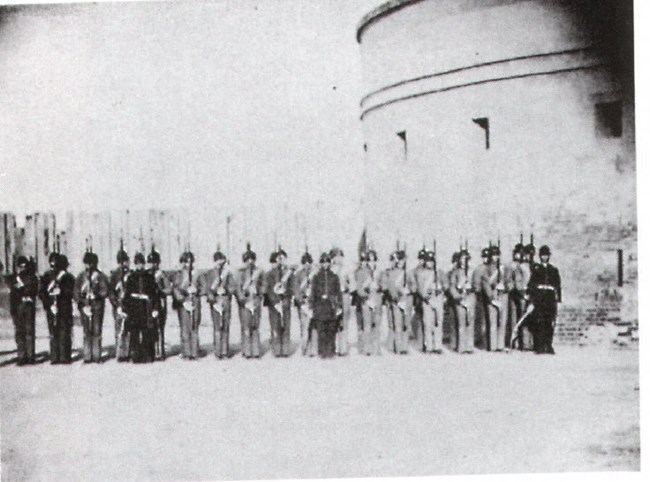
By the time Fort Sumter was built in the mid-nineteenth century new technology-cannons with greater ranges-has transformed Castle Pinckney from a state-of-the-art fort to a relatively insignificant inner harbor defense playing second fiddle to Fort Sumter. Castle Pinckney saw its next period of action between 1832 and 1834 during the Nullification Crisis when it was garrisoned to serve as a storehouse for federal property if South Carolina were to secede. When South Carolina did secede, December 20, 1860 Castle Pinckney was only occupied by a lieutenant, an ordnance sergeant, four mechanics, and thirty laborers-a total of thirty-six people. Only the lieutenant and the ordnance sergeant were part of the U.S. army available to defend the fort. This garrison of two was inadequate to defend the fort, and on December 27, 1860 it earned the ominous distinction of being the first federal installation seized by a seceded state. After First Bull Run, the first major land battle of the war on July 21, 1861, Confederate authorities decided to refit Castle Pinckney as a permanent prison by bricking in gun embrasures to form cells. The work was completed by mid-September and on September 18, 1861, 156 prisoners, members of the 79th and 69th New York, 11th Fire Zouaves (recruited from a fire department in New York), and 8th Michigan regiments, arrived at Castle Pinckney. During their time at Castle Pinckney, the prisoners were allowed to roam around during the day and were only confined to their cells at night. Castle Pinckney quickly became too crowded, and on October 31, 1861 the prisoners were transferred to the Charleston City Jail. In 1863 Castle Pinckney was refitted as an artillery post. Realizing that Fort Sumter and Fort Moultrie would probably fall soon, Confederates authorities strengthened Charleston's inner-harbor defenses. Incorporating lessons learned at Fort Pulaski and Fort Sumter about the effectiveness of rifled artillery against masonry forts, Castle Pinckney's walls were reinforced with large earthen mounds. The original thirty guns were swapped out for four much larger guns mounted on the top or barbette level. On February 18, 1865, following the Confederate evacuation of Charleston, Castle Pinckney returned to United States command. From 1876 to 1917, the fort was primarily used as a lighthouse.In 1924 Calvin Coolidge designated Castle Pinckney as a National Monument. Having never received visitors, Castle Pinckney National Monument was abolished by an act of Congress in 1956. From 1958 to 2011, Castle Pinckney changed hands several times, but the South Carolina State Ports Authority held the deed for the majority of that time. Each organization that has owned Castle Pinckney has struggled with how to fund its preservation and find an appropriate use for the historic structure. In June 2011, the Sons of Confederate Veterans purchased Castle Pinckney from the Ports Authority, but no formal preservation plans have been made. Castle Pinckney is part of an innovative class of fortifications, which forever changed the way the American people defended their shores. Its past is an important part of the American story, and its future is just as important |
Last updated: April 14, 2015
